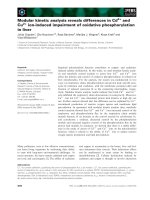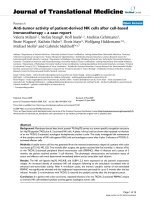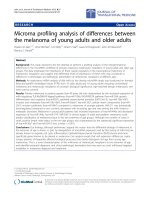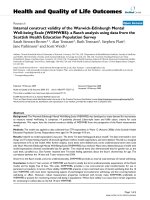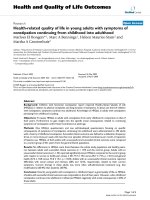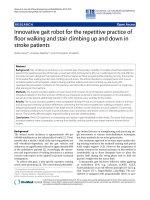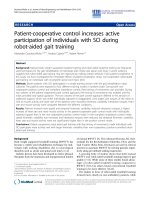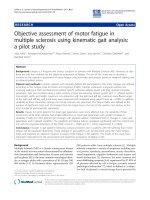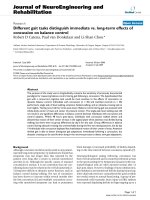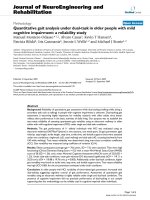báo cáo hóa học: "Quantitative gait analysis under dual-task in older people with mild cognitive impairment: a reliability study" doc
Bạn đang xem bản rút gọn của tài liệu. Xem và tải ngay bản đầy đủ của tài liệu tại đây (441.2 KB, 6 trang )
BioMed Central
Page 1 of 6
(page number not for citation purposes)
Journal of NeuroEngineering and
Rehabilitation
Open Access
Methodology
Quantitative gait analysis under dual-task in older people with mild
cognitive impairment: a reliability study
Manuel Montero-Odasso*
1,2
, Alvaro Casas
3
, Kevin T Hansen
4
,
Patricia Bilski
4
, Iris Gutmanis
4
, Jennie L Wells
1,2
and Michael J Borrie
1,2
Address:
1
Department of Medicine, Division of Geriatric Medicine, Parkwood Hospital, University of Western Ontario, London, ON, Canada,
2
Lawson Health Research Institute, London, ON, Canada,
3
Division of Geriatric Medicine, Hospital Universitario de Getafe, Madrid, Spain and
4
Specialized Geriatric Services, St Joseph's Health Care, London, ON, Canada
Email: Manuel Montero-Odasso* - ; Alvaro Casas - ;
Kevin T Hansen - ; Patricia Bilski - ;
Iris Gutmanis - ; Jennie L Wells - ;
Michael J Borrie -
* Corresponding author
Abstract
Background: Reliability of quantitative gait assessment while dual-tasking (walking while doing a
secondary task such as talking) in people with cognitive impairment is unknown. Dual-tasking gait
assessment is becoming highly important for mobility research with older adults since better
reflects their performance in the basic activities of daily living. Our purpose was to establish the
test-retest reliability of assessing quantitative gait variables using an electronic walkway in older
adults with mild cognitive impairment (MCI) under single and dual-task conditions.
Methods: The gait performance of 11 elderly individuals with MCI was evaluated using an
electronic walkway (GAITRite
®
System) in two sessions, one week apart. Six gait parameters (gait
velocity, step length, stride length, step time, stride time, and double support time) were assessed
under two conditions: single-task (sG: usual walking) and dual-task (dG: counting backwards from
100 while walking). Test-retest reliability was determined using intra-class correlation coefficient
(ICC). Gait variability was measured using coefficient of variation (CoV).
Results: Eleven participants (average age = 76.6 years, SD = 7.3) were assessed. They were high
functioning (Clinical Dementia Rating Score = 0.5) with a mean Mini-Mental Status Exam (MMSE)
score of 28 (SD = 1.56), and a mean Montreal Cognitive Assessment (MoCA) score of 22.8 (SD =
1.23). Under dual-task conditions, mean gait velocity (GV) decreased significantly (sGV = 119.11 ±
20.20 cm/s; dGV = 110.88 ± 19.76 cm/s; p = 0.005). Additionally, under dual-task conditions, higher
gait variability was found on stride time, step time, and double support time. Test-retest reliability
was high (ICC>0.85) for the six parameters evaluated under both conditions.
Conclusion: In older people with MCI, variability of time-related gait parameters increased with
dual-tasking suggesting cognitive control of gait performance. Assessment of quantitative gait
variables using an electronic walkway is highly reliable under single and dual-task conditions. The
presence of cognitive impairment did not preclude performance of dual-tasking in our sample
supporting that this methodology can be reliably used in cognitive impaired older individuals.
Published: 21 September 2009
Journal of NeuroEngineering and Rehabilitation 2009, 6:35 doi:10.1186/1743-0003-6-35
Received: 23 March 2009
Accepted: 21 September 2009
This article is available from: />© 2009 Montero-Odasso et al; licensee BioMed Central Ltd.
This is an Open Access article distributed under the terms of the Creative Commons Attribution License ( />),
which permits unrestricted use, distribution, and reproduction in any medium, provided the original work is properly cited.
Journal of NeuroEngineering and Rehabilitation 2009, 6:35 />Page 2 of 6
(page number not for citation purposes)
Background
A large body of research has demonstrated an important
interdependence between gait and cognition in elderly
people noting that slow motor performance is associated
with cognitive impairment and dementia [1-5]. Walking
is a complex learned task that becomes automatic for
most people from early childhood onwards. However,
there is evidence that cognitive control of gait becomes
increasingly important in older adults[6,7]. Since a semi-
nal study demonstrated that the inability to maintain a
conversation while walking is a marker for future falls in
older adults[8], walking while performing a secondary
task (dual-task paradigm) has become a classic way to
assess the relationship between cognition and gait
Because the dual-task paradigm is a realistic proxy for
daily living activities that seniors may perform at home, it
is growing in interest and application in clinical research
settings.
Although previous studies have reported good test-retest
reliability using electronic walkways while assessing gait
in older people without performing a secondary task [9-
11], the reliability of quantitative gait assessment under
dual-task conditions among those with cognitive prob-
lems has not been established. One of the challenges
faced when assessing cognitively impaired older adults is
their potential inability to perform dual-tasking properly,
thereby increasing measurement error. Therefore, our
objective was to determine the reliability of quantitative
gait assessment under both single and dual-task condi-
tions in people with mild cognitive impairment (MCI)
using a one-week space between assessments. This time-
frame is appropriate for research purposes in this popula-
tion, since gait variables are stable over short intervals.
Establishing the reliability of quantitative gait assessment
under dual-task conditions among those with cognitive
problems is an important first step in validating this
methodology for future longitudinal studies.
Methods
Subjects
Thirteen subjects were recruited from the Aging Brain and
Memory Clinic (ABMC) at Parkwood Hospital, St.
Joseph's Health Care, London, Ontario. Inclusion criteria
were age 65 years and older, a diagnosis of MCI, and abil-
ity to communicate in English. Participants were diag-
nosed with MCI if they[12]: did not have dementia.[13],
had objective memory impairment, experienced subjec-
tive memory symptoms corroborated by an informant,
and had preserved activities of daily living (defined in our
study as being able to perform basic and instrumental
activities of daily living as evaluated by Lawton Brody
Scale[14]). An additional MCI criterion was to have a
Clinical Dementia Rating Scale (CDR) of 0.5[15].
Exclusion criteria included any objective gait disorder due
to Parkinson's disease, previous stroke, clinical osteoar-
thritis in lower limbs joints, myopathy, or neuropathy as
verified by a formal clinical examination. The presence of
depressive symptoms, defined as a score ≥ 5/15 on the
Geriatric Depression Scale[16], was also an exclusion cri-
terion since depression may affect gait performance[16].
The Health Sciences Research Ethics Board at The Univer-
sity of Western Ontario approved the study. Subjects who
consented to participate underwent a comprehensive
medical examination by experienced geriatricians. Co
morbidities, medications, falls in the previous 12 months,
and fear of falling were recorded. Global cognitive status
was assessed using the Mini Mental Status Exam (MMSE;
scored 0-30)[17] and the Montreal Cognitive Assessment
(MoCA; scored 0-30), a validated tool that was originally
created to assist in the diagnosis of MCI[18]. A pattern of
a low MoCA score (<26) with a normal MMSE score (>26)
is associated with having MCI[18].
Procedures
Each participant's gait performance was assessed using an
electronic walkway system (GAITRite
®
) under a single
(three trails) and a dual-task (three trails) condition per
session over two sessions, spaced one week apart. Three
trials per condition was found in the power analysis to be
the optimum number of trials needed to obtain enough
number of strides to be able to compute reliability assess-
ment for the quantitative gait variables of interests[19]
The GAITRite
®
system includes a portable electronic walk-
way mat (600 cm in length and 64 cm in width) for the
automated measurement of spatiotemporal gait parame-
ters. As participants walk along the mat, imbedded sen-
sors are activated by the foot pressure and is deactivated
when the pressure is released. A computer processed the
footsteps, providing data for both spatial and temporal
parameters. The following six gait variables were selected
based on their clinical relevance and their reported associ-
ation with cognitive function in previous aging stud-
ies[5,16,20,21]: gait velocity (cm/s), step length (cm),
stride length (cm), step time (sec), stride time (sec), and
double support time (sec). Gait parameters were recorded
using only the footprint of the participants, thereby elim-
inating the need for external sensors attached to the body
or lower limbs that may interfere with the gait perform-
ance.
GAITRite
®
system resolution is in milliseconds for time
parameters and in millimeters for distances and lengths
parameters. The mat was located in a well-lit, 10-meter
long hallway with starting and ending limits marked one
meter from the mat to avoid recording acceleration and
deceleration phases.
Journal of NeuroEngineering and Rehabilitation 2009, 6:35 />Page 3 of 6
(page number not for citation purposes)
Gait assessments
Prior to the trials, participants were giving standardized
instructions and a visual demonstration. Then, partici-
pants were asked to perform three single-task trials and
three dual-task trials. The single task trials consisted of
walking the length of the mat at self-selected pace (sG).
For the dual-task trials, participants walked the length of
the mat while counting backward from one hundred by
one aloud (dG). This dual-task condition was selected
based on previous research which demonstrated that
counting backwards requires both working memory and
attention[22]. There was no instruction to prioritize either
gait or cognitive task; however, if a participant stopped
either task during the trial they were prompted to con-
tinue. Allowing both aspects to vary, gait and cognitive
task, has previously been shown to better represent the
dynamics of daily living tasks of older adults[23,24].
Data acquisition of the quantitative gait variables
GAITRite software Version 3.8 was used to process the
footstep data using the settings for light and short foot-
steps as individuals with MCI may be more likely to slow
down or hesitate while dual-tasking. If a participant's first
or last footstep did not fall completely within the active
area of the walkway these footstep were manually
removed from the recorded walk. Further, to minimize
environmental variability, evaluations were conducted on
the same weekday (± 1 day) and at the same time of day,
with participants instructed to wear the same pair of shoes
for both sessions.
Statistical analysis
Baseline characteristics and gait parameters were summa-
rized using either means and standard deviations, or fre-
quencies and percentages, as appropriate. For each gait
parameter and for both conditions, the mean of the three
trials was used in the analysis. Three trials was found to be
the optimum number of trials needed to obtain enough
number of strides to be able to compute reliability assess-
ment for the quantitative gait variables of interests[19].
Comparisons between means obtained during sG and dG
conditions were performed using a paired t-test. To quan-
tify gait variability under both single and dual-task condi-
tions, the coefficient of variation[25] (CoV = SD/
mean*100) of each gait variable was calculated at each
time point.
The Intraclass Correlation Coefficient (ICC), based on a
two-way random effects analysis of variance, was used to
quantify test-retest reliability. To interpret ICC values we
used bench marks suggested by Cicchetti (if ICC<0.40, the
level of clinical significance is "poor;" between 0.40 and
0.59 is "fair;" between 0.60 and 0.74 is "good;" and
between 0.75 and 1.00 the level of clinical significance is
"excellent."[26]). We preferred ICC to evaluate test-retest
reliability over a standard correlation analysis because
ICC accounts for differences between data sets by using
analysis of variance. The level of statistical significance
was set at 0.05 and analyses were conducted using SPSS
version 15.0 (SPSS Inc., Chicago IL).
Results
Of the 13 individuals recruited from the ABMC, 2 were
excluded due to gait-affecting comorbidities yielding a
final study group of 11 participants. Demographic and
medical characteristics are summarized in Table 1. In
brief, they were five males and six females, with a mean
age of 76.6 years (SD = 7.3). They were high functioning
in terms of instrumental activities of daily living with a
mean Lawton-Brody = 7.18 out of 8 (SD = 1.06) with
higher scores indicating better functionality Four partici-
pants had experienced a fall in the preceding 12 months.
Global cognitive functioning pattern was consistent with
the diagnosis of MCI[18].
At baseline assessment (week 1), mean gait velocity under
single-task conditions (sG) was significantly faster than
the gait velocity under dual-task conditions (dG) (sG =
119.11 vs. dG = 110.88 cm/s, p = 0.005, Table 2). This
mean decrement of 8.23 cm/s, a seven-percent change, is
considered a clinically significant change in gait veloc-
ity[6,27]. At Week 2, although gait velocity decreased
under dG conditions, the difference in velocity was not
statistically significant (sG: 113.18 vs. dG: 111.84 cm/s, p
= 0.579).
Gait variability results are expressed as CoV in Table 2. Of
the six parameters analyzed, only step and stride time
have significantly increased during dual-task condition
and with considerable stride-to-stride variability. In fact,
the CoV for stride time increased from 6.36 on sG to 11.02
Table 1: Characteristics of the participants (n = 11).
Characteristics Mean (SD)
Age 76.6 (7.3)
Gender - Female: n (%) 6 (54%)
History of at least 1 fall in last 12 months: n (%) 4 (36%)
Body Mass Index (BMI) 25.8 (4.4)
Years of education 14.1 (3.4)
Functional capacity
Lawton-Brody Score IADLs (max. score = 8) 7.18 (1.1)
Global cognition
MMSE Score (0-30) 28 (1.6)
MoCA score (0-30) 22.8 (1.2)
Gait Velocity (cm/s)
Single Gait Velocity (sGV) 119.1 (20.2)
Counting Gait Velocity (cGV) 110.8 (19.8)
Note: SD = Standard deviation; IADL = Instrumental Activities of
Daily Living; MMSE = Mini-Mental State Examination; MoCA =
Montreal Cognitive Assessment.
Journal of NeuroEngineering and Rehabilitation 2009, 6:35 />Page 4 of 6
(page number not for citation purposes)
on dG in week-one assessment. As shown in Figure 1,
under dual task conditions, there was an increase in the
CoV for the variables related to time: step, stride, and dou-
ble support time. For these time-related variables, the CoV
increased by 63.13%, 73.27%, and 36.82% respectively
from sG to dG conditions, while the CoV for the remain-
ing gait variables increased by less than 6%.
Reliability results are shown in Table 2. Under single task
conditions, re-test reliability was excellent with the ICCs
for six gait variables being 0.83 or higher with the excep-
tion of double support time, which was 0.80. Reliability
results under dual-task conditions were also excellent with
ICCs for the six gait measures were 0.93 or higher.
Discussion
This study established the test-retest reliability of gait
assessment under single and dual-task conditions in older
adults with MCI. There is excellent reliability in both con-
ditions over a one-week time span. Reliability of gait
assessment in older adults has been reported previ-
ously[11,20,28]; however, to our knowledge, this is the
first report which determined the reliability under dual-
task conditions in mildly cognitively impaired older peo-
ple. Due to the growing importance of dual-task paradigm
in current research of cognitive decline, falls, and demen-
tia [29-31], our results are of particular relevance since the
presence of cognitive impairment in our population did
not preclude performance of dual-tasking while gait
assessment.
The ICCs for the six variables analyzed under single and
dual-task were higher than 0.75, showing excellent clini-
cal reliability for the assessment of these spatial and tem-
poral gait parameters.
One interesting finding of our study is that the time
required to perform steps and strides significantly
increased under the dual-task condition. This is consistent
with previous studies, which have demonstrated that
these parameters have a greater dependence on brain cor-
tical control than other gait parameters[25,31]. In addi-
tion, step and stride time showed a greater variability
under dual-task conditions when compared with the
other parameters analyzed (Table 2, Figure 1). This find-
ing is particularly relevant given that gait variability under
dual-tasking has been demonstrated to be an early predic-
tor of future falls[8] In our sample of people with Mild
Cognitive Impairment, gait variability significantly
increased under dual-task conditions. While gait variabil-
ity is minimal under dual-task conditions for the general
population, high gait variability is associated with Parkin-
son disease, Alzheimer's disease and other dementias, a
variety of types of dementias and is a predictor of future
falls[25,30,31]. Since our results confirm the reliability of
this assessment in persons with MCI, this type of assess-
ment may be an effective early measure of detecting indi-
Table 2: Overview of the Gait Parameters for Single (sG) and Dual-Task (dG) Conditions.
Single Task Gait (sG)
Week 1 Week 2
Gait Variable Mean (SD) CoV Mean (SD) CoV ICC (95% CI)
Gait velocity (cm/s) 119.11 (20.2) 16.96 113.18 (15.27) 13.49 0.87 (0.52 - 0.97)
Step length (cm) 65.88 (12.03) 18.26 64.04 (10.66) 16.65 0.97 (0.88 - 0.99)
Stride length (cm) 132.07 (24.14) 18.28 128.52 (21.22) 16.51 0.97 (0.89 - 0.99)
Step time (s) 0.55 (0.04) 7.27 0.57 (0.04) 7.02 0.87 (0.51 - 0.96)
Stride time (s) 1.10 (0.07) 6.36 1.13 (0.08) 7.08 0.86 (0.49 - 0.96)
Double support time (s) 0.31 (0.04) 12.90 0.32 (0.04) 12.50 0.80 (0.25 - 0.95)
Dual Task Gait (dG)
Week 1 Week 2
Gait Variable Mean (SD) CoV Mean (SD) CoV ICC (95% CI)
Gait velocity (cm/s) 110.88 (19.76) 17.82 111.84 (17.48) 15.63 0.93 (0.75 - 0.98)
Step length (cm) 65.48 (12.62) 19.27 64.70 (10.49) 16.21 0.97 (0.88 - 0.99)
Stride length (cm) 131.49 (25.25) 19.20 126.86 (20.95) 16.51 0.97 (0.88 - 0.99)
Step time (s) 0.59 (0.07) 11.86 0.58 (0.07) 12.07 0.96 (0.86 - 0.99)
Stride time (s) 1.18 (0.13) 11.02 1.16 (0.13) 11.21 0.96 (0.85 - 0.99)
Double support time (s) 0.34 (0.06) 17.65 0.34 (0.05) 14.71 0.95 (0.82 - 0.99)
Journal of NeuroEngineering and Rehabilitation 2009, 6:35 />Page 5 of 6
(page number not for citation purposes)
viduals with MCI who are at higher risk of future falls.
Increased gait variability represents a more unstable walk-
ing pattern with less rhythmicity. We postulate that this
altered gait pattern is a type of "arrhythmia" of the gait
and may correlate to other health outcomes such as future
dementias, falls or other comorbidities.
Particularly, our results provide support to apply this
methodology in people with cognitive problems.
Although gait has long been considered as primarily an
automatic motor task, emerging evidence suggests that
this view may be overly simplistic[32]. Cortical brain con-
trol may play a key role in the regulation of even routine
walking, specifically through attention. Attention is a nec-
essary cognitive resource for maintaining normal walking
and attentional deficits are independently associated with
postural instability, impairment in performing daily liv-
ing activities, and future falls[24]. Specifically, dual-task-
ing cost has been traditionally related to the prefrontal
cortical regions[33]. These brain regions are crucially
involved in the mediation of the division of attention and
executive function. Functional neuroimaging studies
showed correlations between dual-task performance with
increase activity in prefrontal areas, cingulate, parietal and
premotor areas[34,35]. Therefore, we postulate that those
regions may have a control on gait in older individuals. In
line with previous studies, our results support the hypoth-
esis that occupying these areas with concurrent cognitive
processing (dual-tasking) may result in a brain resource
limitation that affects gait in people with MCI.
Strengths of our study include the use of a well-defined
population that met strict criteria for MCI, and the use of
established and validated measures of cognition using a
sophisticated quantitative gait assessment. The small sam-
ple size of our study, however, is a potential limitation, as
it may not represent the full spectrum of MCI population.
Despite these limitations, this study provides evidence
that quantitative gait analysis while dual-tasking among
older adults with MCI is a reliable methodology.
Conclusion
In older adults with MCI, assessment of quantitative gait
variables using an electronic walkway was highly reliable
under single and dual-task conditions. In line with previ-
ous studies conducted in elderly with normal cognition,
variability of time-related gait parameters increased while
dual-tasking in our sample. The presence of cognitive
impairment did not preclude performance of dual-tasking
gait assessment in our sample; therefore, this methodol-
ogy can be reliably used in older people with MCI.
Competing interests
The authors declare that they have no competing interests.
Gait variability under single and dual tasks for the six gait variables assessed at baselineFigure 1
Gait variability under single and dual tasks for the six gait variables assessed at baseline.
Publish with BioMed Central and every
scientist can read your work free of charge
"BioMed Central will be the most significant development for
disseminating the results of biomedical research in our lifetime."
Sir Paul Nurse, Cancer Research UK
Your research papers will be:
available free of charge to the entire biomedical community
peer reviewed and published immediately upon acceptance
cited in PubMed and archived on PubMed Central
yours — you keep the copyright
Submit your manuscript here:
/>BioMedcentral
Journal of NeuroEngineering and Rehabilitation 2009, 6:35 />Page 6 of 6
(page number not for citation purposes)
Authors' contributions
Study concept and design (MMO and MB), acquisition of
subjects and data (MMO, AC, MB, JW, PB), data analysis
(MMO, KTH, IG), preparation of the manuscript (MMO,
KTH), and critical review of the manuscript (MMO, KTH,
AC, MB, JW, IG). All authors read and approved the final
manuscript.
Acknowledgements
We are grateful for the thoughtful review of the manuscript from Dr. Den-
ise Goens, Clinical Research Office at University of Western Ontario. This
paper was presented at 2008 American Geriatric Society Meeting (Wash-
ington, DC), 2008 Canadian Geriatric Society Meeting (Montreal, QC).
This study was funded by a research grant from the Glenn E Pratt Endow-
ment Fund and the Lawson Health Research Institute at London, ON, Can-
ada. Dr. Montero-Odasso is recipient of the Schulich Clinician-Scientist
Award (2008-2011).
References
1. Camicioli R, Howieson D, Oken B, Sexton G, Kaye J: Motor slowing
precedes cognitive impairment in the oldest old. Neurology
1998, 50:1496-1498.
2. Allan LM, Ballard CG, Burn DJ, Kenny RA: Prevalence and severity
of gait disorders in Alzheimer's and non-Alzheimer's demen-
tias. J Am Geriatr Soc 2005, 53:1681-1687.
3. Holtzer R, Verghese J, Xue X, Lipton RB: Cognitive processes
related to gait velocity: results from the Einstein Aging
Study. Neuropsychology 2006, 20:215-223.
4. Pettersson AF, Olsson E, Wahlund LO: Motor function in subjects
with mild cognitive impairment and early Alzheimer's dis-
ease. Dement Geriatr Cogn Disord 2005, 19:299-304.
5. van Iersel MB, Hoefsloot W, Munneke M, Bloem BR, Olde Rikkert
MG: Systematic review of quantitative clinical gait analysis in
patients with dementia. Z Gerontol Geriatr 2004, 37:27-32.
6. Alexander NB: Gait disorders in older adults. J Am Geriatr Soc
1996, 44:434-451.
7. Woollacott M, Shumway-Cook A: Attention and the control of
posture and gait: a review of an emerging area of research.
Gait Posture 2002, 16:1-14.
8. Lundin-Olsson L, Nyberg L, Gustafson Y: "Stops walking when
talking" as a predictor of falls in elderly people. Lancet 1997,
349:617.
9. Bilney B, Morris M, Webster K: Concurrent related validity of
the GAITRite walkway system for quantification of the spa-
tial and temporal parameters of gait. Gait Posture 2003,
17:68-74.
10. Cutlip RG, Mancinelli C, Huber F, DiPasquale J: Evaluation of an
instrumented walkway for measurement of the kinematic
parameters of gait. Gait Posture 2000, 12:134-138.
11. Menz HB, Latt MD, Tiedemann A, Mun SK, Lord SR: Reliability of
the GAITRite walkway system for the quantification of tem-
poro-spatial parameters of gait in young and older people.
Gait Posture 2004, 20:20-25.
12. Petersen RC, Smith GE, Waring SC, Ivnik RJ, Tangalos EG, Kokmen
E: Mild cognitive impairment: clinical characterization and
outcome. Arch Neurol 1999, 56:303-308.
13. American Psychiatric, Association: Diagnostic and Statistical
Manual of Mental Disorders (Text Revision; [DSV-IV-TR]).
Washington, DC 4th edition. 2000.
14. Lawton MP, Brody EM: Assessment of older people: self-main-
taining and instrumental activities of daily living. Gerontologist
1969, 9:179-186.
15. Morris JC: The Clinical Dementia Rating (CDR): current ver-
sion and scoring rules. Neurology 1993, 43:2412-2414.
16. van Iersel MB, Haitsma A, Olde Rikkert MG, Benraad CE: Quantita-
tive gait analysis to detect gait disorders in geriatric patients
with depression. J Am Geriatr Soc 2005, 53:1441-1442.
17. Folstein MF, Folstein SE, McHugh PR: "Mini-mental state". A
practical method for grading the cognitive state of patients
for the clinician. J Psychiatr Res 1975, 12:189-198.
18. Nasreddine ZS, Phillips NA, Bedirian V, Charbonneau S, Whitehead
V, Collin I, et al.: The Montreal Cognitive Assessment, MoCA:
a brief screening tool for mild cognitive impairment. J Am
Geriatr Soc 2005, 53:695-699.
19. Donner A, Eliasziw M: Sample size requirements for reliability
studies. Stat Med 1987, 6:441-448.
20. van Iersel MB, Benraad CE, Rikkert MG: Validity and reliability of
quantitative gait analysis in geriatric patients with and with-
out dementia. J Am Geriatr Soc 2007, 55:632-634.
21. Verghese J, Wang C, Lipton RB, Holtzer R, Xue X: Quantitative
gait dysfunction and risk of cognitive decline and dementia.
J Neurol Neurosurg Psychiatry 2007, 78:929-935.
22. Hittmair-Delazer M, Semenza C, Denes G: Concepts and facts in
calculation. Brain 1994, 117(Pt 4):715-728.
23. Verghese J, Kuslansky G, Holtzer R, Katz M, Xue X, Buschke H, et al.:
Walking while talking: effect of task prioritization in the eld-
erly. Arch Phys Med Rehabil 2007, 88:50-53.
24. Yogev-Seligmann G, Hausdorff JM, Giladi N: The role of executive
function and attention in gait. Mov Disord 2008, 23:329-342.
25. Hausdorff JM: Gait variability: methods, modeling and mean-
ing. J Neuroengineering Rehabil 2005, 2:19.
26. Cicchetti DV: Guidelines, criteria, and rules of thumb for eval-
uating normed and standardized assessment instruments in
psychology. Psychological Assessment 1994, 6:284-290.
27. Bendall MJ, Bassey EJ, Pearson MB: Factors affecting walking
speed of elderly people. Age Ageing 1989, 18:327-332.
28. van Uden CJ, Besser MP: Test-retest reliability of temporal and
spatial gait characteristics measured with an instrumented
walkway system (GAITRite). BMC Musculoskelet Disord 2004,
5:13.
29. Bootsma-van der Wiel A, Gussekloo J, de Craen AJ, van Exel E, Bloem
BR, Westendorp RG: Walking and talking as predictors of falls
in the general population: the Leiden 85-Plus Study. J Am Ger-
iatr Soc 2003, 51:1466-1471.
30. Sheridan PL, Solomont J, Kowall N, Hausdorff JM: Influence of
executive function on locomotor function: divided attention
increases gait variability in Alzheimer's disease. J Am Geriatr
Soc 2003, 51:1633-1637.
31. Springer S, Giladi N, Peretz C, Yogev G, Simon ES, Hausdorff JM:
Dual-tasking effects on gait variability: the role of aging, falls,
and executive function. Mov Disord 2006, 21:950-957.
32. Hausdorff JM, Yogev G, Springer S, Simon ES, Giladi N: Walking is
more like catching than tapping: gait in the elderly as a com-
plex cognitive task. Exp Brain Res 2005, 164:541-548.
33. Chao LL, Knight RT: Prefrontal deficits in attention and inhibi-
tory control with aging.
Cereb Cortex 1997, 7:63-69.
34. Klingberg T, O'Sullivan BT, Roland PE: Bilateral activation of
fronto-parietal networks by incrementing demand in a work-
ing memory task. Cereb Cortex 1997, 7:465-471.
35. Klingberg T: Limitations in information processing in the
human brain: neuroimaging of dual task performance and
working memory tasks. Prog Brain Res 2000, 126:95-102.
